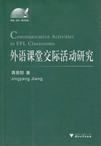外语课堂交际活动研究
出版时间:2006-8 出版社:浙江大学 作者:蒋景阳 页数:171
前言
认识蒋景阳老师是在博士课程班。她的求学精神和积极向上的态度给我留下了很深的印象。当她在她的学术专著《外语课堂交际活动研究》将要付梓之前请我写序时,我欣然答应了。 蒋景阳从事大学英语教学二十年、大学英语教学管理多年,具有丰富的教学和管理经验。在最近18个学期的由学生进行的教学评估中,她得到17次优秀。可见,她具有的先进教学理念和课堂掌控能力,深得学生的喜爱。可以说,这本有关课堂交际活动的书,是她多年教学经验的总结,是一部厚积薄发、水到渠成的作品。 改革开放以来,我国的外语教学得到了迅猛的发展,教学规模和质量都有了很大的提高。尤其是最近几年我国加了世贸组织、申奥和申博的成功等重要事件,使我国在政治、经济、文化和教育各领域对外开放的广度和深度有了新的拓展,对能够使用外语交际的人才的需求也随之增加。如何培养出具有外语交际能力的人才对我们广大的外语老师来说是一个挑战。目前,无论是国内还是国外,专门论述中国大学英语课堂教学的书不多,针对口语交际能力的论著更为稀少。因此,蒋景阳老师的这本专著可以说填补了这方面的空白。
内容概要
认识蒋景阳老师是在博士课程班。她的求学精神和积极向上的态度给我留下了很深的印象。当她在她的学术专著《外语课堂交际活动研究》将要付梓之前请我写序时,我欣然答应了。 蒋景阳从事大学英语教学二十年、大学英语教学管理多年,具有丰富的教学和管理经验。在最近18个学期的由学生进行的教学评估中,她得到17次优秀。可见,她具有的先进教学理念和课堂掌控能力,深得学生的喜爱。可以说,这本有关课堂交际活动的书,是她多年教学经验的总结,是一部厚积薄发、水到渠成的作品。 改革开放以来,我国的外语教学得到了迅猛的发展,教学规模和质量都有了很大的提高。尤其是最近几年我国加了世贸组织、申奥和申博的成功等重要事件,使我国在政治、经济、文化和教育各领域对外开放的广度和深度有了新的拓展,对能够使用外语交际的人才的需求也随之增加。如何培养出具有外语交际能力的人才对我们广大的外语老师来说是一个挑战。目前,无论是国内还是国外,专门论述中国大学英语课堂教学的书不多,针对口语交际能力的论著更为稀少。因此,蒋景阳老师的这本专著可以说填补了这方面的空白。
书籍目录
IntroductionChapter 1 An Overview of College English Teaching in China1.1 Teaching Methodology1.1.1 Grammar Translation Method1.1.2 The Direct Method1.1.3 The Audiolingual Method1.1.4 Communicative Language Teaching1.1.5 Communicative Language Learning1.1.6 Suggestopedia1.1.7 The Silent Way1.1.8 TheTotal Physical Response Method1.1.9 The Natural Approach1.1.10 The Present Teaching Methods in China1.2 The Teaching Staff and the Teaching Facilities1.2.1 The Unsatisfactory Teacher Resources1.2.2 The Causes of Unsatisfactory.Teacher Resources1.2.3 Teacher Education1.2.4 Teaching Facilities1.3 Syllabuses and Textbooks1.3.1 The Definition of Syllabus1.3.2 A Brief Introduction to the College English Syllabus1.3.3 The 1985 and the 1986 Syllabus1.3.4 The 1999 Syllabus1.3.5 The 2004 College English Curriculum Requirements1.3.6 College English Textbooks1.4 The CET and CET-SET1.4.1 The College English Test1.4.2 The Spoken English Test1.5 The Needs of the Units and Students1.6 The Present English Level of College English Students"1.7 Teaching Reform1.7.1 Teaching Approach1.7.2 Teaching Mode1.7.3 Focus on Communicative Ability1.7.4 Better Classroom Organization1.8 Course DesignChapter 2 Related Concepts in Second Language Acquisition2.1 Communicative Competence2.2 The Input Hypothesis2.3 The Output Hypothesis2.4 Interaction Hypothesis and Language Acquisition2.5 The Intedanguage2.6 Negative FeedbackChapter 3 Classroom Interaction and Second Language Acquisition3.1 Classroom Interaction3.2 Teacher-student Interaction3.3 Student-student Interaction3.4 Negotiation of Meaning3.5 Classroom Participation PatternsChapter 4 Different Forms of Activities and Language Learning4.1 Distinctions between Language Activities4.1.1 McTears Distinction4.1.2 Paulston and Bruders Distinction4.1.3 William Littlewoods Category4.1.4 Elliss Framework4.1.5 Brown and Yules Distinction4.1.6 Van Liers Framework4.1.7 Bygates Distinction4.1.8 Prabhus Category4.1.9 Clarks Communicative Activity Types4.1.10 Patti sons Seven Activity Types4.1.11 Chaudron and Valcances Activity Types4.2 Group Work4.2.1 The Advantages of Group Work4.2.2 The Disadvantages of Group Work4.2.3 Fallacies of Group Work4.3 Explorations into Some Communicative Activities4.3.1 Monologue4.3.2 Pair Work4.3.3 Role Play4.3.4 Simulation4.3.5 Information Gap Activity4.3.6 Problem Solving4.3.7 Opinion Exchange4.3.8 Brainstorming4.3.9 Skit/Putting on a Short Play4.3.10 Games4.4 Communicative Activities and Language Learning"Chapter 5 Roles of the Teacher and the Learner.5.1 The Teachers Role.,5.1.1 From a Controller to an Organizer5.1.2 From an Instructor to a Facilitator5.1.3 From an Assessor to a Commentator"5.1.4 From an Actor to a Director5.1.5 A Co-communicator or Participant5.1.6 A Consultant or Prompter5.2 Learners Role"5.2.1 From a Quiet Listener to an Active Participator5.2.2 From a Recipient to a Creator5.2.3 From a Follower to an Initiator5.2.4 From a Speaker to a Communicator5.2.5 From a Passive Learner to an Autonomous Learner.Chapter 6 Principles of Designing Communicative Activities6.1 Maximizing Participation by Assigning Roles to Each Participant6.2 Information Gap as a Goal for Interaction6.3 Meaning Negotiation for Generating More Input6.4 Promoting Long Turns6.5 Communication-based Activities for Real Communication6.6 The Cultural DimensionChapter 7 Suggestions for Organizing Oral Activities7.1 When Students Are Not Motivated7.2 When Learners Do Not Open Their Mouth7.3 When Learners Resort to Their Mother Tongue7.4 When Learners Dont Achieve Mutual Understanding7.5 When Learners Make Linguistic and Non-linguistic Errors7.6 When the Audience Doesnt ListenChapter 8 SummaryReferences
章节摘录
It is widely acknowledged that English is becoming more and moreimportant as a vehicle for communication with the outside world both foracquiring and exchanging information. To know a language means being able tounderstand what one reads and hears, and to speak and write in that language. InChina, English enjoys a critical position in the curriculum from elementaryschool to university. Most Chinese students are learning English at every levelof their studies, even in graduate school. Despite the fact that departments andschool authorities have attached so much importance to the English language,English education in China is still not very successful. It is possible for studentsto learn English for over ten years and yet still not be able to say one sentencefluently, confidently and appropriately. Whether it is a common situation is notfor me to say, however, I can state that the speaking ability or communicativecompetence of the learners must be improved and enhanced so as to meet theincreasing demand of the developing social needs, It has long been the case that Chinese learners (probably not only Chineselearners) have an imbalanced ability in reading, listening, speaking and writing.Students are generally better at reading and listening than speaking and writing.Between speaking and writing, speaking is unquestionably the more difficultskill for students to learn. Kachru (1985: 12——15) proposes three concentriccircles of English for world Englishes: the inner circle, the outer circle, and theexpanding circle. These circles represent the types of spread, the patterns ofacquisition, and the functional domains in which English is used across culturesand languages. The use of English in China belongs to the third circle since it isused as a foreign language. It is learned through long-term formal training.English being a foreign language means that the out-of-class English learningenvironment is sorely lacking. The classroom as a learning environment shouldassume a more important role for English learning, especially for the skill of.speaking. In order to take full advantage of precious classroom time, it isnecessary to explore what actually happens in the classroom. This constitutesthe central component of classroom research.
图书封面
评论、评分、阅读与下载
用户评论 (总计0条)
推荐图书
- 昆明大理丽江黄金指引
- 行政侵权损害赔偿简明读本
- 中考语文课外阅读试题精选
- 1980-2005-深圳勘察设计25年-市政交通工程篇
- 江西房地产十五回望
- 谈美书简
- 《城市中低压配电网改造技术导则》DL/T599-2005条文解释
- 螺旋塔羅
- 安全教育与正当防卫
- 青青河畔草
- 微机原理及接口技术
- 建筑电气工程施工与安装
- I CAN!校园听读英语
- I CAN!校园听读英语
- I CAN!校园听读英语(小学4年级) (平装)
- 最新实用英语应用能力考试模拟
- 大学英语自学指导(下册)
- 实用大学英语教程预备教程
- 实用大学英语教程(第1册)
- 跨平台软件开发
- 八年级-阅读
- 电业安全工作规程考核题库
- 心理治疗
- 让英语课堂活起来
- 高中物理解题思路16讲
相关图书
- 历代名家篆刻字典
- 职业成就事业-你究竟为谁工作
- 大学计算机基础学习指导
- 公路工程财务管理
- Visual Basic程序设计基础/世纪精品计算机等级考试书系
- 青藏线旅游专列导游图
- 中华人民共和国外资银行管理条例
- Windows XP Professional/2003系统管理标准教程
- 操作系统原理与实践教程
- 五笔字型速学速查字典
- 五笔高手特训班
- CorelDRAW X3中文版范例导航
- 边用边学CorelDRAW-(中文版)(含光盘)
- 有理有例
- 双语时代2005年第一季度合辑
- B双语时代(2005第二季度合辑附MP3光碟)
- 城市公共交通科技管理
- 看成功故事学英语
- 看哲理故事学英语
- 看爱情故事学英语
- 戴高乐传
- 巴顿传
- 钢琴进阶教程
- 新编证据法学
- 制定法时代的普通法
